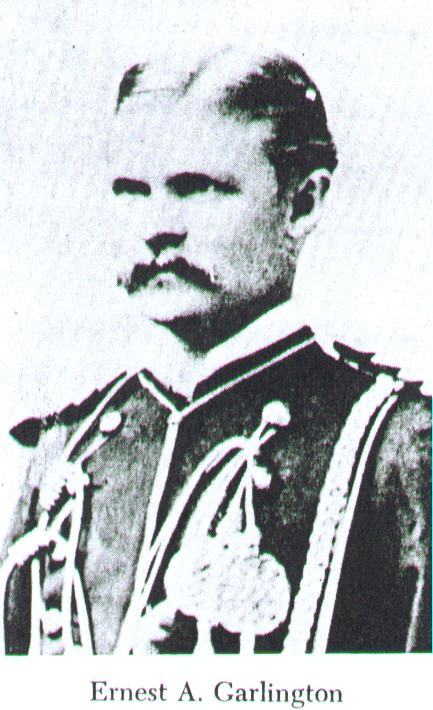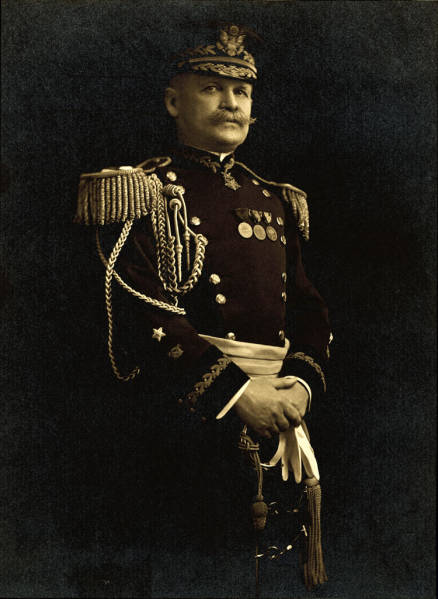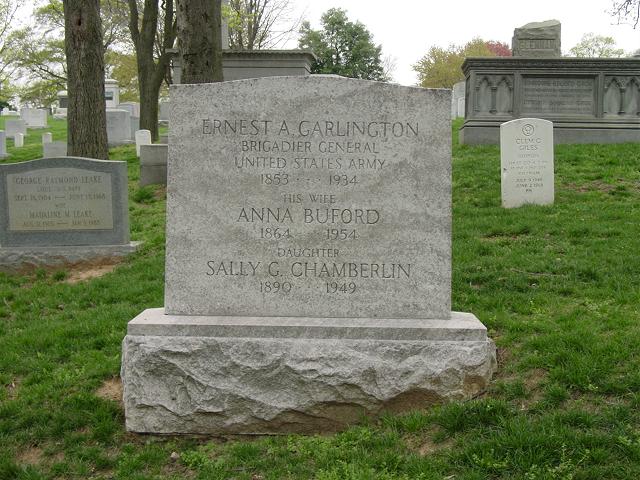Born at Newberry Hill, South Carolina, February 20, 1853, he received his education at the University of Georgia, 1869-72 and graduated from West Point in 1876.
He was commissioned a Second Lieutenant, 7th United States Cavalry, June 15, 1876 and was subsequently promoted through the grades to Brigadier General, Inspector General of the Army, October 1, 1906.
He commanded the Greely Relief Expedition in 1883; was severely wounded in battle with hostile Indians at Wounded Knee, South Dakota, December 29, 1890. He was awarded the Medal of Honor for distinguished gallantry in that action.
He was a member of a board which established Cavalry drill instructions, 1894; Inspector General in Cuba during the Spanish-American War, 1898; was present at the battle and siege and then surrender of Santiago de Cuba in that war; was Inspector General of the Division of the Philippines during the Insurrection there, 1899-1901 and May 2, 1905-June 4, 1906; served on the General Staff of the Army from October 1, 1906. He was the author of “Historical Sketches of the Seventh Cavalry Regiment: A Catechism:” “Cavalry Outposts,”; “Advance and Rear Guards Reconnaissance.”
He died on October 16, 1934 and was buried in Section 3 of Arlington National Cemetery. His first wife, Anna Buford Garlington (1864-1954) and his daughter, Sally Chamberlain Garlington (1890-1949), are buried with him.
It is interesting to note that he was assigned to the Seventh Cavalry too late to have taken part in the Battle of the Little Big Horn.
NOTE: His son, Cresswell Garlington, Brigadier General, United States Army, is also buried in Arlington National Cemetery.
Ernest Albert Garlington of South Carolina
Appointed from Georgia, Cadet, United States Military Academy, 1 July 1872 (30)
Second Lieutenant, 7th United States Cavalry, 15 June 1876
First Lieutenant, 25 June 1876
Regimental Adjutant, 6 June 1877 to 30 November 1881
Captain, 3 December 1891
Major, Inspector General, 2 January 1895
Lieutenant Colonel, 7 July 1898
Colonel, 1 Mar 1901
Awarded the Medal of Honor 26 September 1893 for distinguished gallantry in action against hostile Sioux Indians on Wounded Knee Creek, South Dakota, 29 December 1890 where he was severely wounded while serving as First Lieutenant, 7th United States Cavalry.
GARLINGTON, ERNEST A.
Rank and organization: First Lieutenant, 7th U.S. Cavalry. Place and date: At Wounded Knee Creek, South Dakota., 29 December 1890. Entered service at: Athens, Georgia. Born: 20 February 1853, Newberry, South Carolina. Date of issue: 26 September 1893.
Citation: Distinguished gallantry.
GENERAL GARLINGTON, 81, DIES; FOUGHT SIOUX
Won Congressional Medal of Honor For Gallantry at Wounded Knee Creek
Arm Hurt Permanently
Brigadier an Inspector General From 1906 to 1917 When he Was Retired
SAN DIEGO, California, October 17, 1934 – Brigadier General Ernest A. Garlington, holder of the Congressional Medal of Honor died here yesterday in his eighty-second year.
Upon graduating from West Point in the Spring of 1876 General Garlington was assigned to Custer’s Seventh Cavalry. Ten days later, while he was preparing to go West, General Custer and two squadrons of his command were eliminated by the Indians at the battle of the Little Big Horn. He was appointed a First Lieutenant and joined the shattered remains of the regiment on August 1, 1876.
The Medal of Honor was awarded to the General for “distinguished gallantry in action against the hostile Sioux Indians on Wounded Knee Creek, South Dakota, on December 29, 1890, where he was severely wounded while serving as First Lieutenant, Seventh Cavalry.” In the battle, Garlington had drawn his revolver, rallied his men and was directing a return fire, steadying his force by his example and cool commands. A rifle ball tore through his right arm, smashing forearm and elbow and lower part of the upper arm. He fell, bleeding badly, but remained conscious. From the ground he continued to direct his men. The arm retained a permanent stiffness from the wound.
Garlington remained with the Seventh Cavalry until transferred to the Inspector General’s Department as a Major in January 1895. He was Inspector General of the Cavalry Division in Cuba in the War with Spain, and served throughout the campaign in Cuba. Raised to a Colonelcy in 1901, he was appointed Inspector General in 1901, he was appointed Inspector General in October 1906 with the rank of Brigadier General, and held the post until his retirement on account of age in February 1917, two months before the United States entered the World War.
General Garlington is also remembered for the ill-fated expedition he led in an unsuccessful attempt to relieve the Greely Arctic exploration party in 1883. He had volunteered for the assignment. An ice pack smashed the Proteus, the relief ship, which was abandoned, and other misfortunes followed. A court of inquiry exonerated General Garlington.
GARLINGTON, ERNEST A
- BRIG GEN US ARMY RET
- VETERAN SERVICE DATES: Unknown
- DATE OF DEATH: 10/16/1934
- DATE OF INTERMENT: 10/23/1934
- BURIED AT: SECTION SOUTH SITE 1735B
ARLINGTON NATIONAL CEMETERY
GARLINGTON, ANNA BUFORD WID/O ERNEST A
- DATE OF BIRTH: 09/02/1864
- DATE OF DEATH: 10/25/1954
- DATE OF INTERMENT: 10/28/1954
- BURIED AT: SECTION 3 SITE 1735-B
- ARLINGTON NATIONAL CEMETERY
- WIFE OF EA GARLINGTON BRIG GEN U S A RETIRED
Michael Robert Patterson was born in Arlington and is the son of a former officer of the US Army. So it was no wonder that sooner or later his interests drew him to American history and especially to American military history. Many of his articles can be found on renowned portals like the New York Times, Washingtonpost or Wikipedia.
Reviewed by: Michael Howard



